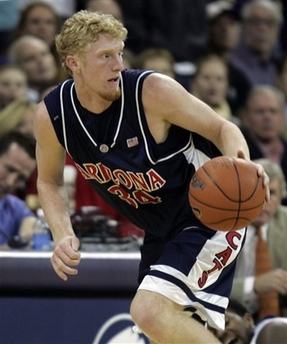
Mike Schmidt
Playing on a talented Arizona team, Budinger had a good freshman season, managing to stand out as a lottery prospect despite the lack of team chemistry and tournament success for the Wildcats. Rather than opting for the draft, the shooting guard decided to try and boost his stock and improve his all-around game with a second year in Tucson.
As he proved last year, Budinger has all the physical tools to stand out in the NBA as a shooting guard. In addition to great leaping ability and blazing speed up and down the floor, he also possesses good size for the position, standing somewhere around 67. Though the sophomore has elite athletic ability, he must continue to spend time in the weight room in order to become physically stronger.
Offensively, Budinger plays his best basketball in transition, where his athletic abilities allow him to do a number of things. He made a number of highlight finishes while filling the lanes last season, using excellent body control to adjust around defenders, and being a regular recipient of alley-oop passes from Mustafa Shakur. On the break, he can finish successfully with either hand, while adjusting his body around the defense in traffic.
Budinger has ability beyond just being an athlete, however, primarily with a shooting stroke that shows great promise. Featuring excellent elevation on his jumper, he has a very consistent release point, an area where many leapers struggle when it comes to shooting. At this point in his career, Budinger is more accurate on the catch and shoot. His ability to make a jumper off the dribble was inconsistent throughout last season, and will be an area that scouts will watch closely to project how versatile of an offensive threat he might develop into in the NBA.
In the half court, Budinger scores the majority of his points on either spot-up jumpers or quick drives to take advantage of off-balance defenses. Despite his athletic ability, Budinger isnt the type of player to score a lot of points on isolation looks in the half-court, largely due to his underdeveloped ball-handling skills. The sophomore guard rarely loses his handle, but lacks the ability to utilize any type of advanced dribble to get his man off-balance and create an easy lane to the basket in one on one situations. Budinger looks a bit mechanical at times in this area, lacking the craftiness and body control in traffic that makes him such an effective finisher in transition. This led him to pass off or settle for a raw looking mid-range jumper rather than take the ball strong to the basket and utilize his athleticismwhich is what makes him such an intriguing prospect to begin with. For an elite athlete like Budinger, three free throw attempts per game is much too low, especially considering he shot 84% from the charity stripe last season.
For a freshman, Budinger played very efficient basketball last season, and his basketball IQ was especially evident in his off the ball movement. While playing on the weak side, he often found open spots on the floor for open looks from behind the arc. Budinger was also perpetually in movement, and oftentimes caught the defense sleeping by slipping into the lane on a backdoor cut for an easy lay-up. He also looked highly unselfish in the way he operated in the half-court setsometimes to a faultbut nevertheless impressing with his ability to find the open man and play within the team concept.
Defensively, the sophomore guard shows good promise as well. Budinger has the lateral quickness to stay with his man on the perimeter, and positions his body well enough to cut off most defenders when they attempt to take him off the dribble. The ability to react quickly and elevate also helps him contest shots, even if he sometimes loses ideal position on the defensive end. Help defense will need to be an area of focus for Budinger, who too often got caught ball-watching on rotations. He rebounded the ball well for a swingman last season, especially considering that he was usually the first player filling the lanes next to the point guard on the fast break. The success in this area can be attributed to Budingers willingness to locate the nearest opposing player after a shot attempt, and use his body to keep them away from the ball.
Added intensity would also do a great deal to help Budinger on the court. As a freshman, he played with a business-like approach on the court, showing very little in terms of emotion or leadership. With more of an aggressive approach to the game, it will help Arizona advance further as a team in addition to boosting the draft stock of Budinger. Scouts will surely want to see more of a go-to scoring mentality from him if hes to be projected as the elite prospect his upside says he could be.
The Wildcats lost scorers Marcus Williams and Ivan Radenovic from last years team, and it will be interesting to see if Budinger steps up and becomes the leading player for Arizona, or if that role will be taken by talented freshman guard Jerryd Bayless.
As he proved last year, Budinger has all the physical tools to stand out in the NBA as a shooting guard. In addition to great leaping ability and blazing speed up and down the floor, he also possesses good size for the position, standing somewhere around 67. Though the sophomore has elite athletic ability, he must continue to spend time in the weight room in order to become physically stronger.
Offensively, Budinger plays his best basketball in transition, where his athletic abilities allow him to do a number of things. He made a number of highlight finishes while filling the lanes last season, using excellent body control to adjust around defenders, and being a regular recipient of alley-oop passes from Mustafa Shakur. On the break, he can finish successfully with either hand, while adjusting his body around the defense in traffic.
Budinger has ability beyond just being an athlete, however, primarily with a shooting stroke that shows great promise. Featuring excellent elevation on his jumper, he has a very consistent release point, an area where many leapers struggle when it comes to shooting. At this point in his career, Budinger is more accurate on the catch and shoot. His ability to make a jumper off the dribble was inconsistent throughout last season, and will be an area that scouts will watch closely to project how versatile of an offensive threat he might develop into in the NBA.
In the half court, Budinger scores the majority of his points on either spot-up jumpers or quick drives to take advantage of off-balance defenses. Despite his athletic ability, Budinger isnt the type of player to score a lot of points on isolation looks in the half-court, largely due to his underdeveloped ball-handling skills. The sophomore guard rarely loses his handle, but lacks the ability to utilize any type of advanced dribble to get his man off-balance and create an easy lane to the basket in one on one situations. Budinger looks a bit mechanical at times in this area, lacking the craftiness and body control in traffic that makes him such an effective finisher in transition. This led him to pass off or settle for a raw looking mid-range jumper rather than take the ball strong to the basket and utilize his athleticismwhich is what makes him such an intriguing prospect to begin with. For an elite athlete like Budinger, three free throw attempts per game is much too low, especially considering he shot 84% from the charity stripe last season.
For a freshman, Budinger played very efficient basketball last season, and his basketball IQ was especially evident in his off the ball movement. While playing on the weak side, he often found open spots on the floor for open looks from behind the arc. Budinger was also perpetually in movement, and oftentimes caught the defense sleeping by slipping into the lane on a backdoor cut for an easy lay-up. He also looked highly unselfish in the way he operated in the half-court setsometimes to a faultbut nevertheless impressing with his ability to find the open man and play within the team concept.
Defensively, the sophomore guard shows good promise as well. Budinger has the lateral quickness to stay with his man on the perimeter, and positions his body well enough to cut off most defenders when they attempt to take him off the dribble. The ability to react quickly and elevate also helps him contest shots, even if he sometimes loses ideal position on the defensive end. Help defense will need to be an area of focus for Budinger, who too often got caught ball-watching on rotations. He rebounded the ball well for a swingman last season, especially considering that he was usually the first player filling the lanes next to the point guard on the fast break. The success in this area can be attributed to Budingers willingness to locate the nearest opposing player after a shot attempt, and use his body to keep them away from the ball.
Added intensity would also do a great deal to help Budinger on the court. As a freshman, he played with a business-like approach on the court, showing very little in terms of emotion or leadership. With more of an aggressive approach to the game, it will help Arizona advance further as a team in addition to boosting the draft stock of Budinger. Scouts will surely want to see more of a go-to scoring mentality from him if hes to be projected as the elite prospect his upside says he could be.
The Wildcats lost scorers Marcus Williams and Ivan Radenovic from last years team, and it will be interesting to see if Budinger steps up and becomes the leading player for Arizona, or if that role will be taken by talented freshman guard Jerryd Bayless.
#2: Brook Lopez, 70, PF/C, Sophomore, Stanford
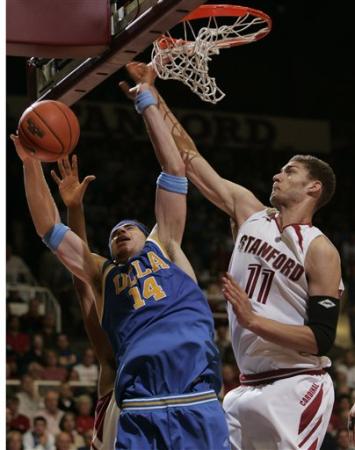
Rodger Bohn
The more offensively gifted of the Lopez twins, Brook will be relied upon greatly this upcoming season in a Stanford offense that struggled at times putting points on the board in their 06-07 campaign. Playing alongside another seven footer (his twin Robin), he will have the opportunity to show off his skills from the perimeter yet again, while also earning more opportunities to go one on one with another big man for defenses to key upon.
Numbers are deceiving for Lopez, as he started the season off at nowhere near 100%, coming off of back surgery. Although he posted a respectable scoring average of 12.6 points per game, the Stanford post scored nearly 18 points per game in the final 8 games of his freshman campaign. His ability to score inside and out gave defenses fits late in the year, with his Cardinal teammates giving him increased touches in the pivot.
When on the blocks, Brook has two main moves that he likes to go to: A smooth right handed hook shot and a turnaround jumper. While it might be frustrating for some to see a player seven feet tall fading away from the basket in order to score his points, Lopez has shown the ability to knock down this shot with consistency. His soft touch allows him to get many shooters bounces and help him convert on the multitude of inside baskets he gets through cuts and offensive rebounds. Two areas of concern in terms of Brooks skills down low are his non-existent left hand and inability to pass the ball out of double teams. He often counts on his size down low, using his right hand at times where he would clearly be more beneficial by using his left. Lopez struggles mightily when faced with a double team, often duped into turnovers or forced shots. Both of these areas must be improved upon if he hopes to reach his optimum draft stock after his sophomore season. He also can be a bit on the soft side at times on the offensive end, shying away from contact and loafing around near the three point arc a bit more then youd like to see.
Stepping away from the basket is where Brook appears to prefer to play on the offensive end, however. Possessing range out to college three point line, he was able to open up the floor for his brother Robin with his ability to score from the perimeter. We had the chance to observe Lopez this summer during an open gym session at the LeBron James Skills Academy, where we were surprised to see that he can even shoot the ball with consistency out to the NBA three point line. His capability to stretch the defense and create one on one opportunities for teammates will only help him in the eyes of NBA scouts.
On the defensive end, Brook will come into his sophomore season as one of the top candidates for the PAC-10 Defensive Player of The Year award. His ability to block shots was on display throughout the entire season, especially during his remarkable twelve block performance versus USC in late January. What is even more impressive about Lopezs ability to block shots is that he is able to do it without getting in foul trouble, averaging only 2.7 fouls per game last season. His timing, length, and ability to intimidate with either hand puts him amongst the top defensive big men prospects in this draft. While his relatively meager average of only 6 rebounds per game might be a bit alarming, that number is a bit misleading due to the fact that Lopez played only 25.6 minutes per game.
Lopez is blessed with excellent physical attributes-- including a legit seven foot body, outstanding wingspan, and above average leaping ability for a center prospect. His frame is not carrying anything close to its maximum weight, as it could stand to gain another 20 pounds or so easily. The big man does a nice job running the floor, often filling the wings in transition and beating opposing centers down the floor for easy buckets.
This season could serve as a breakout year for Lopez, given that he is now at full health and is blessed with two outstanding frontcourt mates in his brother Robin and Lawrence Hill. Playing alongside those two will not allow opposing defenses to double team him, which should result in increased statistical output. Anyway you look at it, Lopez enters this season as one of the elite big men prospects in the NCAA, and a player who could easily land in the lottery if he is able to build upon his bright freshman season.
Numbers are deceiving for Lopez, as he started the season off at nowhere near 100%, coming off of back surgery. Although he posted a respectable scoring average of 12.6 points per game, the Stanford post scored nearly 18 points per game in the final 8 games of his freshman campaign. His ability to score inside and out gave defenses fits late in the year, with his Cardinal teammates giving him increased touches in the pivot.
When on the blocks, Brook has two main moves that he likes to go to: A smooth right handed hook shot and a turnaround jumper. While it might be frustrating for some to see a player seven feet tall fading away from the basket in order to score his points, Lopez has shown the ability to knock down this shot with consistency. His soft touch allows him to get many shooters bounces and help him convert on the multitude of inside baskets he gets through cuts and offensive rebounds. Two areas of concern in terms of Brooks skills down low are his non-existent left hand and inability to pass the ball out of double teams. He often counts on his size down low, using his right hand at times where he would clearly be more beneficial by using his left. Lopez struggles mightily when faced with a double team, often duped into turnovers or forced shots. Both of these areas must be improved upon if he hopes to reach his optimum draft stock after his sophomore season. He also can be a bit on the soft side at times on the offensive end, shying away from contact and loafing around near the three point arc a bit more then youd like to see.
Stepping away from the basket is where Brook appears to prefer to play on the offensive end, however. Possessing range out to college three point line, he was able to open up the floor for his brother Robin with his ability to score from the perimeter. We had the chance to observe Lopez this summer during an open gym session at the LeBron James Skills Academy, where we were surprised to see that he can even shoot the ball with consistency out to the NBA three point line. His capability to stretch the defense and create one on one opportunities for teammates will only help him in the eyes of NBA scouts.
On the defensive end, Brook will come into his sophomore season as one of the top candidates for the PAC-10 Defensive Player of The Year award. His ability to block shots was on display throughout the entire season, especially during his remarkable twelve block performance versus USC in late January. What is even more impressive about Lopezs ability to block shots is that he is able to do it without getting in foul trouble, averaging only 2.7 fouls per game last season. His timing, length, and ability to intimidate with either hand puts him amongst the top defensive big men prospects in this draft. While his relatively meager average of only 6 rebounds per game might be a bit alarming, that number is a bit misleading due to the fact that Lopez played only 25.6 minutes per game.
Lopez is blessed with excellent physical attributes-- including a legit seven foot body, outstanding wingspan, and above average leaping ability for a center prospect. His frame is not carrying anything close to its maximum weight, as it could stand to gain another 20 pounds or so easily. The big man does a nice job running the floor, often filling the wings in transition and beating opposing centers down the floor for easy buckets.
This season could serve as a breakout year for Lopez, given that he is now at full health and is blessed with two outstanding frontcourt mates in his brother Robin and Lawrence Hill. Playing alongside those two will not allow opposing defenses to double team him, which should result in increased statistical output. Anyway you look at it, Lopez enters this season as one of the elite big men prospects in the NCAA, and a player who could easily land in the lottery if he is able to build upon his bright freshman season.
#3: Darren Collison, 61, Point Guard, Junior, UCLA
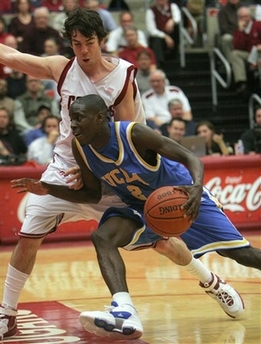
Joseph Treutlein
Poised to emerge as one of the best point guards in college basketball next season, Darren Collison brings a very well-rounded skill-set and a true floor generals mentality to the table for UCLA, where he did a great job stepping into a starting role last season. Collison plays bigger than his size, as he stands only 61 while weighing a mere 165 pounds, but makes up for it with his length and toughness.
Collison boasts a good inside-out game offensively, having an explosive first step and great craftiness, allowing him to get past his defender nearly at will. He does a good job changing directions once in the lane, being able to weave through defenders with his low-to-the-ground handle, and is excellent at changing speeds to get past his man, using his explosiveness especially well in that regard. When he takes the ball to the basket, Collison finishes well for his size, showing good touch around the basket. He has struggled at times when trying to go head on into bigger, more athletic defenders, though, something that could pose a problem at the next level, as hell almost always have to go around defenders in the lane to score, not being able to finish over them.
Collison also possesses a very effective outside jumper, even though he has an awkward overhead motion. When given the time to get his feet underneath him and the space to get off his shot, Collison is deadly from behind the three-point arc, though he struggles a bit when pressured, not showing the same consistency. Collison is actually a better shooter from behind the three-point arc than from mid-range, mostly because he often isnt able to get the space he needs on his pull-up jumper inside the arc, which isnt something he consistently converts. There are some question marks about the way his awkward shooting mechanics will translate to the further extended range of the NBA 3-point line, and whether bigger, longer and more athletic defenders will give him trouble in terms of getting his shot off.
In terms of running his teams offense, Collison does an excellent job managing the pace of the game and balances creating his own offense and offense for his teammates well. Collison really has the total package with his distribution abilities, reading pick-and-roll situations very well, dishing off to teammates on drives in the lane, pushing the ball in transition, and just moving the ball around in the half-court to find open teammates on the perimeter. Collison might be at his best playing the pick-and-roll, as he can get enough space to drain his outside shot, read the defense to make the assist to an open teammate, or use his explosiveness to blow by his defenders, being able to consistently beat the defense each way.
Defensively, Collison really excels at the college level, playing good fundamental man-to-man defense on the perimeter, showing good anticipation in the passing lanes, playing good pressure defense when needed, and having good lateral quickness as well. He does tend to struggle at times with ball screens, not quite having the strength to get around them. Collison may not be as effective at the next level due to his size (already questionable at 6-0 to 6-1), but should be at least an above average defender because of his fundamentals and basketball IQ.
Collison could very likely enter the NBA draft following this season, being on pace to graduate from UCLA as a Junior, and should be right in lottery talks if he picks up where he left off from last season, which all indications are he will. He still has plenty of room to improve, especially if he can tweak his jump shot to be a little bit better pulling up and when contested. It wouldnt be impossible for him to be a starting point guard at the next level, but hes no sure thing either. Regardless, with his all-around game, pure point guard mentality, and willingness to give his all on both ends of the court, he should at the very least be a more than capable back-up point guard.
Collison boasts a good inside-out game offensively, having an explosive first step and great craftiness, allowing him to get past his defender nearly at will. He does a good job changing directions once in the lane, being able to weave through defenders with his low-to-the-ground handle, and is excellent at changing speeds to get past his man, using his explosiveness especially well in that regard. When he takes the ball to the basket, Collison finishes well for his size, showing good touch around the basket. He has struggled at times when trying to go head on into bigger, more athletic defenders, though, something that could pose a problem at the next level, as hell almost always have to go around defenders in the lane to score, not being able to finish over them.
Collison also possesses a very effective outside jumper, even though he has an awkward overhead motion. When given the time to get his feet underneath him and the space to get off his shot, Collison is deadly from behind the three-point arc, though he struggles a bit when pressured, not showing the same consistency. Collison is actually a better shooter from behind the three-point arc than from mid-range, mostly because he often isnt able to get the space he needs on his pull-up jumper inside the arc, which isnt something he consistently converts. There are some question marks about the way his awkward shooting mechanics will translate to the further extended range of the NBA 3-point line, and whether bigger, longer and more athletic defenders will give him trouble in terms of getting his shot off.
In terms of running his teams offense, Collison does an excellent job managing the pace of the game and balances creating his own offense and offense for his teammates well. Collison really has the total package with his distribution abilities, reading pick-and-roll situations very well, dishing off to teammates on drives in the lane, pushing the ball in transition, and just moving the ball around in the half-court to find open teammates on the perimeter. Collison might be at his best playing the pick-and-roll, as he can get enough space to drain his outside shot, read the defense to make the assist to an open teammate, or use his explosiveness to blow by his defenders, being able to consistently beat the defense each way.
Defensively, Collison really excels at the college level, playing good fundamental man-to-man defense on the perimeter, showing good anticipation in the passing lanes, playing good pressure defense when needed, and having good lateral quickness as well. He does tend to struggle at times with ball screens, not quite having the strength to get around them. Collison may not be as effective at the next level due to his size (already questionable at 6-0 to 6-1), but should be at least an above average defender because of his fundamentals and basketball IQ.
Collison could very likely enter the NBA draft following this season, being on pace to graduate from UCLA as a Junior, and should be right in lottery talks if he picks up where he left off from last season, which all indications are he will. He still has plenty of room to improve, especially if he can tweak his jump shot to be a little bit better pulling up and when contested. It wouldnt be impossible for him to be a starting point guard at the next level, but hes no sure thing either. Regardless, with his all-around game, pure point guard mentality, and willingness to give his all on both ends of the court, he should at the very least be a more than capable back-up point guard.
#4: DeVon Hardin, 611, Center, Senior, California
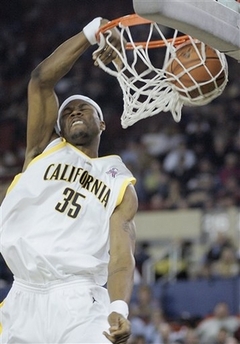
Kyle Nelson
After a foot injury shortened his junior season, DeVon Hardin entered draft conversations with a few good workouts and first-round rumors. Luckily for Cal, he came back for his senior season and alongside Ryan Andersen, should form one of the most fearsome frontcourts on the west coast. While it is an overstatement to say that his improvements will make or break the Golden Bears, the potential he showed last season certainly has college basketball fans and draft pundits talking.
Hardins most intriguing features, as theyve always been, are his physical gifts--notably his size and athleticism. Standing a legitimate 611 and looking every bit of 235 pounds, his body, athleticism, and ability to run the floor recall Jermaine ONeal. While he could stand to gain a few more pounds (which should be no problem considering his frame), there are very few college athletes on his level physically and athletically.
Hardin uses these gifts well on the defensive end. He moves well in the paint and is a good man defender, capable of playing decent help defense, and blocking around two shots a game. The key to his defensive abilities, however, is focus and a lack thereof. If he could play consistent defense and maintain his focus on the floor, he could easily be the best post defender in college basketball. Because of his athleticism and size, he is a very good rebounder at the college level and averaged 8.3 boards a game in just under 27 minutes a game. He could be just as good at the next level if he continues to stay focused and box out on every play, but he wont be as physically superior in the NBA as he is in college.
However, besides his talent to throw down emphatic dunks in transition, he is painfully limited on the offensive end. Its a shame to see a guy with Hardins size and athleticism shy away from fundamental post play, but he too often settles for hurried jump hooks instead of backing down his man. Developing a better left hand might serve Hardin well, also. Perhaps the most enticing of Hardins potential, however, is his ability to knock down the open jumper. He is a good shooter both from mid-range and the foul line (82%) and hopefully will continue to improve.
If were looking as his impact in the PAC-10, there is no doubt that Hardin is going to be a major factor and a potential double-double performer. Against fellow post prospects, he is going to be a formidable defensive presence and should continue to be an anchor in the middle for the Golden Bears. On the NBA front, he was rumored to have a first round promise last year from the Pistons at #27, but a breakout season with steady improvements on the offensive end could land him in the lottery. All of the potential is there; its Hardins to realize.
Hardins most intriguing features, as theyve always been, are his physical gifts--notably his size and athleticism. Standing a legitimate 611 and looking every bit of 235 pounds, his body, athleticism, and ability to run the floor recall Jermaine ONeal. While he could stand to gain a few more pounds (which should be no problem considering his frame), there are very few college athletes on his level physically and athletically.
Hardin uses these gifts well on the defensive end. He moves well in the paint and is a good man defender, capable of playing decent help defense, and blocking around two shots a game. The key to his defensive abilities, however, is focus and a lack thereof. If he could play consistent defense and maintain his focus on the floor, he could easily be the best post defender in college basketball. Because of his athleticism and size, he is a very good rebounder at the college level and averaged 8.3 boards a game in just under 27 minutes a game. He could be just as good at the next level if he continues to stay focused and box out on every play, but he wont be as physically superior in the NBA as he is in college.
However, besides his talent to throw down emphatic dunks in transition, he is painfully limited on the offensive end. Its a shame to see a guy with Hardins size and athleticism shy away from fundamental post play, but he too often settles for hurried jump hooks instead of backing down his man. Developing a better left hand might serve Hardin well, also. Perhaps the most enticing of Hardins potential, however, is his ability to knock down the open jumper. He is a good shooter both from mid-range and the foul line (82%) and hopefully will continue to improve.
If were looking as his impact in the PAC-10, there is no doubt that Hardin is going to be a major factor and a potential double-double performer. Against fellow post prospects, he is going to be a formidable defensive presence and should continue to be an anchor in the middle for the Golden Bears. On the NBA front, he was rumored to have a first round promise last year from the Pistons at #27, but a breakout season with steady improvements on the offensive end could land him in the lottery. All of the potential is there; its Hardins to realize.
#5: Jordan Hill, 6-9, Power Forward, Sophomore, Arizona
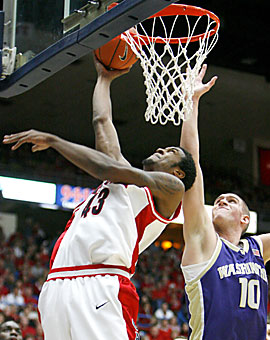
Jonathan Givony
One of the few bright spots in a very disappointing season for the Arizona Wildcats was the emergence of freshman power forward Jordan Hill, widely considered a project going into the year. Not having played organized basketball as a high school junior and largely unknown until being discovered at an AAU event late in 2005 (where he was essentially offered a scholarship on the spot by Lute Olson), Hill went from barely playing at all for the Wildcats (6 ½ minutes per in the first 18 games) to a major contributor after replacing Marcus Williams in the rotation against Arizona State on January 24th. He responded with a solid 12 point, 9 rebound performance, and from that point on was off and on the bench constantly (23 minutes per in the last 11 games) giving Arizona some of the size and athleticism they sorely lacked in the post. With Williams and Radenovic out of the picture now, Lute Olson and his staff will undoubtedly turn to Hill to try and make up for the production they lost and establish some sort of post presence for them on both ends of the floor.
Physically, Hill fits the description of an NBA prospect and then some. A superb athlete, with long arms, a good frame, and cat-like quickness getting off his feet, Hill is clearly a gifted prospect. With that said, he looks nowhere near a finished product at this extremely early stage in his development. Everything you get from him comes in small doses, but even those small doses transmit a tremendous amount of optimism regarding his upside.
Hill has good hands and really nice instincts to chase offensive rebounds and blocked shots, but is still extremely skinny and very much a work in progress in terms of his fundamentals and knowledge of the game. He cant create much offense for himself due to his below average footwork, even if he does show some promise here with the occasional jump-hook, and tries to dunk everything that comes his way. His left hand is certainly improvable, as is the range on his jumper, but he will step away from the basket on occasion and knock down a good looking shot from mid-range. Most of his production comes from the fact that hes so much more athletic than most of the big guys he matches up with at the college level, which is part of the reason why Hill was so inconsistent once he did get off the bench. Playing in Arizonas up-tempo offense is a great fit, though, and certainly helps mask his shortcomings in the half-court as long as he has creators next to him.
Defensively is where Hill will need to show the most improvement over the next few years to go from prospect to player in the minds of NBA scouts. His lack of experience and high level coaching from a young age immediately becomes evident here, particularly in his lack of footwork and awareness on team assignments. He also has a tendency to leave his feet a little too early chasing blocked shots wildly, and thus will get into foul trouble on occasion. His focus level in general could stand to improve, as he ranges from being extremely active to very passive depending on when you catch him.
Adding strength is a major priority for him, as its not rare to see him lose his balance or get outmuscled in the post when matching up with players who are more physically mature than him. Even though he often just outquicks other players for dunks immediately after he makes a catch and finish in the post (using his impressive wingspan in particular), he struggles finishing through contact when the defensive rotation meets him at the hoop.
All in all considering the natural progression that most big men go throughparticularly late bloomers--as long as Hill does not buy into his own hype and continues to work hard, his future looks extremely bright.
Physically, Hill fits the description of an NBA prospect and then some. A superb athlete, with long arms, a good frame, and cat-like quickness getting off his feet, Hill is clearly a gifted prospect. With that said, he looks nowhere near a finished product at this extremely early stage in his development. Everything you get from him comes in small doses, but even those small doses transmit a tremendous amount of optimism regarding his upside.
Hill has good hands and really nice instincts to chase offensive rebounds and blocked shots, but is still extremely skinny and very much a work in progress in terms of his fundamentals and knowledge of the game. He cant create much offense for himself due to his below average footwork, even if he does show some promise here with the occasional jump-hook, and tries to dunk everything that comes his way. His left hand is certainly improvable, as is the range on his jumper, but he will step away from the basket on occasion and knock down a good looking shot from mid-range. Most of his production comes from the fact that hes so much more athletic than most of the big guys he matches up with at the college level, which is part of the reason why Hill was so inconsistent once he did get off the bench. Playing in Arizonas up-tempo offense is a great fit, though, and certainly helps mask his shortcomings in the half-court as long as he has creators next to him.
Defensively is where Hill will need to show the most improvement over the next few years to go from prospect to player in the minds of NBA scouts. His lack of experience and high level coaching from a young age immediately becomes evident here, particularly in his lack of footwork and awareness on team assignments. He also has a tendency to leave his feet a little too early chasing blocked shots wildly, and thus will get into foul trouble on occasion. His focus level in general could stand to improve, as he ranges from being extremely active to very passive depending on when you catch him.
Adding strength is a major priority for him, as its not rare to see him lose his balance or get outmuscled in the post when matching up with players who are more physically mature than him. Even though he often just outquicks other players for dunks immediately after he makes a catch and finish in the post (using his impressive wingspan in particular), he struggles finishing through contact when the defensive rotation meets him at the hoop.
All in all considering the natural progression that most big men go throughparticularly late bloomers--as long as Hill does not buy into his own hype and continues to work hard, his future looks extremely bright.















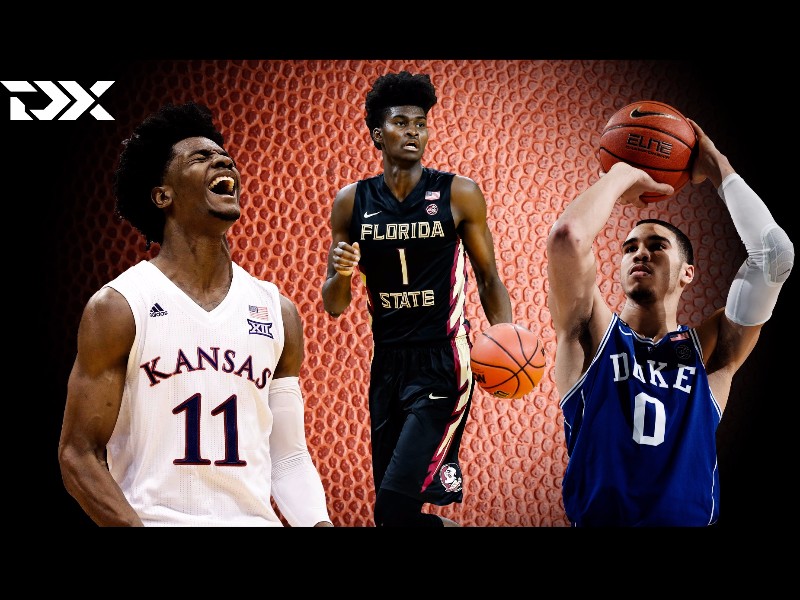
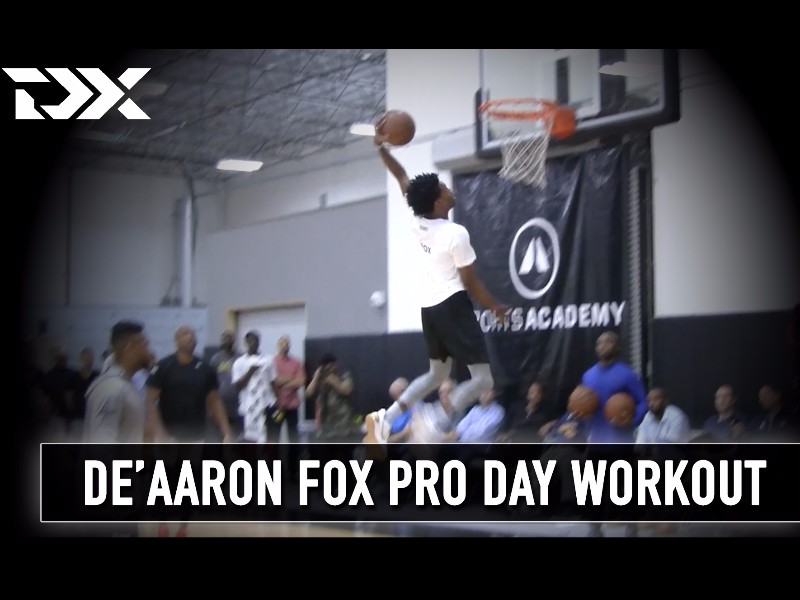



















Comments